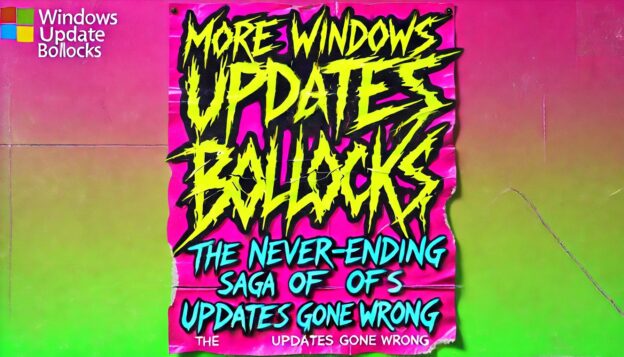Ah, Windows Updates, the perennial thorn in the side of PC users everywhere. Promised as the silent guardians of stability and security, they’ve instead become a source of frustration, disruption, and the occasional catastrophic system crash. Whether it’s an update that bricks your machine or one that installs itself at the worst possible time, Windows Updates have earned their reputation for being, well, bollocks.
Let’s dig into the myths, annoyances, and absurdities of the Windows Update experience in part twenty-eight of my articles from my satirical comedic polemic series.
“Updates Keep Your PC Secure”
The main selling point of Windows Updates is that they protect your system from vulnerabilities, keeping hackers at bay. While this is true in theory, the reality is far messier. Updates often patch security holes, but they also introduce new bugs, incompatibilities, and performance issues.
Even worse, Microsoft’s track record of pushing out updates before they’re fully tested leaves many users wondering if the cure is worse than the disease. The promise that updates will keep your PC “secure” sometimes feels like bollocks when they leave your machine barely functional.
“We’ll Update When It’s Convenient for You”
Microsoft claims that updates are designed to install at times that won’t disrupt your work. But let’s be honest: Windows Updates have an uncanny knack for choosing the most inconvenient moments to restart your PC. Need to present in 5 minutes? Surprise! Windows is configuring updates. Deadline looming? Let’s install updates for the next 45 minutes.
The idea that updates respect your schedule is one of the most infuriating pieces of Windows Update bollocks.
“Updates Won’t Impact Performance”
Another common refrain is that updates improve performance, ironing out bugs and optimizing your system. Yet time and again, users report sluggish systems, increased memory usage, and random crashes after installing the latest update. Let’s not forget the infamous updates that broke printer functionality or mysteriously erased user files.
The claim that updates are performance-neutral or performance-enhancing? More marketing bollocks than actual experience.
“Automatic Updates Are for Your Own Good”
Windows’ insistence on automatic updates is framed as a safeguard against security risks. But this heavy-handed approach often leaves users feeling like they’ve lost control of their own machines. Whether it’s an update that forces a restart mid-project or one that installs unwanted features, the lack of choice is frustrating.
The idea that Microsoft knows what’s best for every user, all the time? Patronizing bollocks that assumes one-size-fits-all works for complex systems.
“Patch Tuesday: Reliable and Predictable”
Microsoft’s scheduled “Patch Tuesday” is meant to bring order and predictability to the update process. But ask any IT professional, and they’ll tell you that Patch Tuesday often feels like Russian roulette. Will it fix critical issues, or will it break something else entirely? Only time will tell.
The promise of a predictable, reliable update schedule is just another piece of bollocks when every patch feels like a gamble.
“Windows Updates Bring New Features”
Sure, updates occasionally introduce new features, but how many of them are actually useful? For every helpful addition, there are countless bloatware-like features no one asked for. Remember the “3D Paint” fiasco or the half-baked integration of Cortana? These so-called features often feel more like experiments at the user’s expense.
The narrative that updates always bring valuable new tools is padded with unnecessary bollocks that clutters rather than enhances.
“You Can Pause Updates Anytime”
Microsoft proudly advertises the option to pause updates, giving users a supposed reprieve from the constant interruptions. But this feature is often a temporary fix, and once the pause period ends, you’re right back in update purgatory. The idea that pausing updates puts you in control is superficial bollocks at best.
“The Update Process is Seamless”
Seamless? If by seamless, you mean sitting through multiple reboots, cryptic error messages, and hours of “Configuring Updates,” then sure. But for most users, the update process is anything but smooth. The endless progress bars and vague status updates feel like they’re mocking you.
The promise of a “seamless” update process is laughable bollocks when it feels more like a trial by fire.
“You Can Roll Back Problematic Updates”
Yes, technically, you can roll back a bad update. But the process is far from user-friendly, often requiring a combination of obscure settings, troubleshooting tools, and crossed fingers. And even when you manage to revert, you’re left wondering when the next update will drag you back into chaos.
The idea that rolling back updates is a simple fix? Overly optimistic bollocks that underestimate how infuriating it can be.
“Windows Updates Are Getting Better”
With every new version of Windows, we’re told that the update process is “better than ever.” Yet each iteration seems to introduce its own set of quirks and frustrations. From the forced updates of Windows 10 to the resource-heavy updates of Windows 11, the experience remains a mixed bag at best.
The notion that updates are improving over time feels like classic PR bollocks designed to pacify frustrated users.
Conclusion: Updates Need an Update
Windows Updates are a necessary evil, but the promises surrounding them are often exaggerated or downright misleading. From poorly timed restarts to performance issues and half-baked features, the update experience leaves much to be desired.
If Microsoft wants to improve user trust, it’s time to ditch the bollocks and focus on delivering updates that are truly seamless, reliable, and respectful of users’ time. Until then, we’ll keep bracing for the worst every Patch Tuesday.
